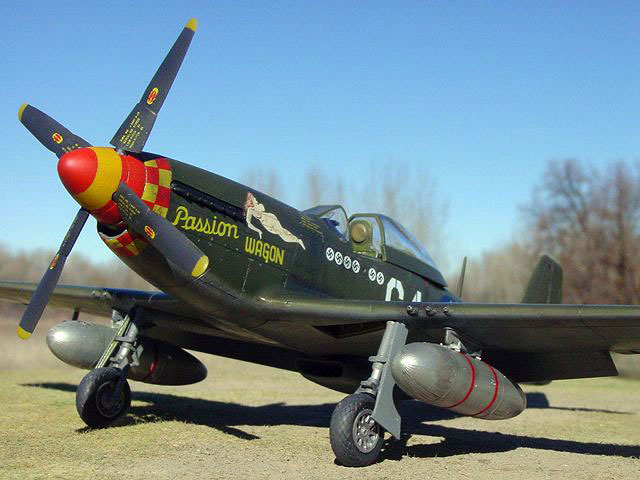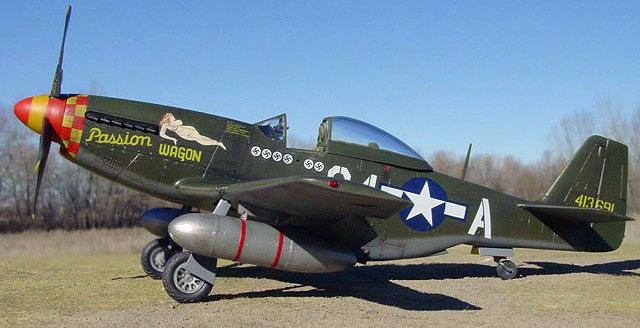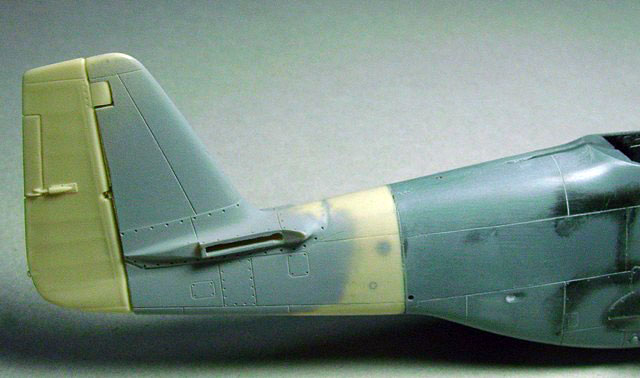|
Passion Wagon in 1/48
P-51D Mustang
by
Ian Robertson
|
 |
|
P-51D Mustang |

Tamiya's 1/48 scale P-51D Mustang is available online from Squadron.com
Most P-51D Mustangs have a small fillet on the rear
fuselage spine in front of the tail. However, the first P-51D's to roll
off the assembly line lacked this fillet, as did the earlier versions of
the Mustang. The tail fillet was deemed necessary in the P-51D when
stability problems arose following the introduction of the bubble
canopy.
Current P-51D offerings in 1/48 scale from Tamiya and Hasegawa do not
include a filletless tail option. While either kit could be modified
directly with modest effort (removing the fillet, filling and reforming
the upper spine and leading edge of the tail, and scribing the
appropriate panel lines), Ultracast makes an inexpensive resin
filletless tail conversion for the Tamiya kit that simply plugs into the
existing fuselage following a single cut. I suppose one could also use
the tail from a Tamiya P-51B/C, but this would be a more expensive
option than the resin conversion.

Using the Ultracast conversion, along with Ultracast exhausts and
SuperScale decals (#48-692), I have built "Passion Wagon", an early
P-51D of the 357th Fighter Group piloted by Lt. Arval Roberson.
Tamiya's P-51D Mustang is arguably the best
bubbletop Mustang available in 1/48 scale, although Hasegawa's comes a
close second. A major advantage of the Tamiya kit is the option for
dropped or raised flaps. Surface detail on the kit is excellent, and the
cockpit is adequately detailed, although replacement resin cockpits are
available.
Ultracast's filletless tail conversion for the Tamiya kit was a breeze
to complete. The assembled kit fuselage was cut in two pieces along a
panel line ahead of the tail fillet. The main component of the
four-piece resin replacement (tail plus positionable rudder and two gear
doors) was then plugged into position using CA glue as a fastener. A
small amount of Tamiya putty and sanding was needed to smooth the
connection. The kit's horizontal stabilizers fit directly into the
replacement tail, as did the kit's tail wheel.

Several other modifications and additions were made
to the kit:
-
Kit exhausts were
replaced with Ultracast resin exhausts (item #48009)
-
Eduard seat belts were
added
-
Gun sight reflector was
made from clear acetate
-
110 gallon "paper" drop
tanks taken from Tamiya's P-47 kit
-
Raised rivet detail on
wing surfaces was removed (these rivets were not found on WWII Mustangs
- they are a structural modification on refurbished P-51 warbirds)
-
Main gear door were
positioned up to match my reference photograph. These doors would have
gradually dropped while the aircraft was parked.
 Overall
the cockpit was painted interior green using Polly Scale acrylic. The
cockpit floor was treated to a wood finish made from light brown paint
and a wood-grain decal, and the radio equipment and instrument panel
were painted scale black. Overall
the cockpit was painted interior green using Polly Scale acrylic. The
cockpit floor was treated to a wood finish made from light brown paint
and a wood-grain decal, and the radio equipment and instrument panel
were painted scale black.
Using Polly Scale acrylics, I applied a camouflage
scheme of RAF green over Neutral Gray. Panel lines were darkened
slightly using a thinned mixture of burnt umber and raw sienna enamel.
Minor scratches and rivet details were made with a silver pencil.
The drop tanks were sprayed with Alclad II semi-matte aluminum and
aluminum.

The entire model was treated with a clear gloss coat of Future floor wax
prior to the application of decals. Decals used were a combination of
SuperScale sheet 48-692 and the kit decals. Specifically, I used the
SuperScale decals for the nose art, fuselage codes and tail codes, and
the Tamiya decals for the insignias and checker pattern on the nose.
Painting the spinner proved a challenge because it was difficult finding
a match for Tamiya's interpretation of red on their checker decals. In
the end I settled on Boyd's "Sunburst" enamel (made by Testors), which
had the same orange tinge as the Tamiya decal. The yellow was painted
using Polly Scale's "orange yellow" acrylic. Despite the problem finding
a color match for the red, I opted for the Tamiya checker decal because
it fit the model better than the SuperScale decal.
I found it necessary to modify the nose art slightly because the
SuperScale figure differed in appearance from a photograph of "Passion
Wagon" in Jeffrey Ethell's book "Air Command". The decal has the
figure's left elbow protruding awkwardly behind her head, yet the
photograph in Ethell's book shows her arm much more comfortably
positioned, reaching back to hold her neck or hair. Therefore, I decided
to remove the elbow protruding from behind her head. However, my
attempts to reposition the arm properly didn't meet with much success so
I decided to leave it be rather than make a mess of it. In my view the
revised figure looks much better than the original decal, even if it is
not completely correct. It is worth mentioning that because nose art was
sometimes modified in the field, SuperScale's interpretation could match
their reference material.
Images of the completed model were taken outdoors
with a SONY digital camera set at its highest picture resolution (2048 x
1536 pixels). Other camera settings were as follows: 200 ISO film speed,
800-1000th/sec shutter speed, F-stop 8.0, and fixed focus distance of
either 20 or 30 cm. Images were cleaned up using Adobe Photoshop 6.0 for
the Macintosh.
The interface between the base and background were
merged using the software's "blur" tool, and edges all photographs were
sharpened using the "sharpen edges" tool. Sharpening images in such a
way helps to restore some of the clarity lost during image compression.
Click on the thumbnails
below to view larger images:
P-51 Mustang
From the RAF to the Mighty Eighth
Special Editions (Aviation) 1 |
|
|
|
|
Author: Michael O'Leary
US Price: $10.95
UK Price: £6.99
Publisher:
Osprey Publishing
Publish Date:
September 15, 1997
Details: 128 pages; ISBN: 1855327147 |
|
|
Model, Images and Text Copyright ©
2004 by Ian Robertson
Page Created 02 April, 2004
Last Updated 02 April, 2004
Back to HyperScale
Main Page
|
Home
| What's New |
Features |
Gallery |
Reviews |
Reference |
Forum |
Search